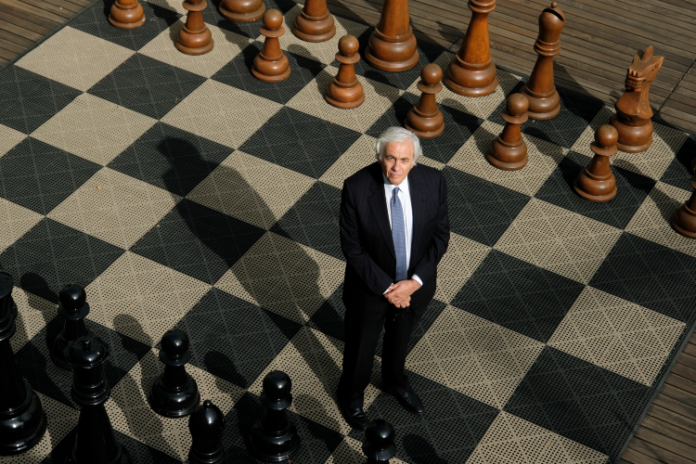But now Rand faces a new challenge according to its leadership: the assault on basic established facts and objective research that has been building for the last several years. For a nonprofit like Rand, whose mission is to analyze facts to provide policy recommendations for decisionmakers, not being able to rely on commonly agreed upon facts and truths hits at the core of its business.
What’s more, Rand itself is on the cusp of a leadership transition. In October, its Chief Executive Michael Rich announced his retirement effective next year after 11 years at the helm and a 47-year career at the think tank. A search is now underway for his successor.
In an interview, Rich laid out in stark terms what he sees as the looming threat to Rand, a think tank, contract research outfit and graduate educational institution with nearly 1,900 employees in four countries and grant and contract revenue of $364 million last year.
“Rand is an idea that the best way of solving complex policy problems is to start with facts and subject them to rigorous analysis,” he said. “If the facts themselves can’t be believed, then that’s an existential threat to Rand as well as to our entire system of governance.”
Not just a think tank
Not just a think tank
Initially, Rand was focused on research and policy analysis for U.S. military decisionmakers, just as the Cold War was coming to dominate military strategy. Rand’s hallmark was producing research and policy analysis reports with clear, practical recommendations that its decisionmaker clients could easily enact into law or policy.
In the late 1980s, the think tank faced its first existential threat: the winding down of the Cold War and resulting cutbacks in defense spending.
Rand was not totally unprepared. During the 1980s, it ramped up research into different policy arenas, especially health care, according to Al Carnesale, former UCLA chancellor and former dean of the Kennedy School of Government at Harvard University in Cambridge, Mass. Carnesale has had nonfinancial associations with Rand researchers and executives since the 1970s; he received an honorary degree from the Pardee Rand Graduate School in 2010.
“Their transition started before the Cold War ended,” Carnesale said. “They were big on health care policy as far back as the early 1980s.”
But the diminished role of the military — Defense Department-related work now comprises about 45% of Rand’s total work by dollar volume — forced it to do more work on a contract-specific basis where its clients came to the table with funding for the research, Carnesale said. That meant doing research Rand’s clients wanted.
“In that kind of situation, there’s always the danger of delivering research with a predetermined outcome that the researchers believe the client wants,” he said.
Rand has so far worked to avoid this trap through its own fundraising, building up an endowment through donations and investments that reached $280 million last year. That endowment can be tapped to allow Rand to do its own research and policy analysis into key challenges without having to rely on customers to fund and dictate the areas or terms of research.
As a result, Rand has now evolved into a unique institution: a combination of think tank, contract research organization and educational institution with no single peer or competing organization.
“We have competitors for research contracts and grants, we have competitors for what we call ‘mind share’ or public attention — think tanks like the Brookings Institution (in Washington, D.C.) — and we have competitors on the university front,” Rich said. “But no single competitor cuts across all three of these areas.”
Cross-disciplinary approach
Cross-disciplinary approach
“We are focused on support for America’s military and veteran families, especially volunteer caregivers for injured veterans,” said Steve Schwab, the foundation’s chief executive. “But when we launched, we had no idea how many caregivers there were, nor how much was being saved in medical costs, nor what these volunteer caregivers needed. So, we turned to Rand to find out.”
The study Rand produced in 2014 for $1.5 million found that there were more than 6 million of these volunteer caregivers — mostly family members — that collectively were saving $15 billion a year in medical costs. And, Schwab said, the study made policy recommendations that were translated into four pieces of legislation enacted within a year or two of the report’s release.
“Some research organizations set up in silos, but Rand put military and veteran experts together with health researchers, population experts and social program experts,” Schwab said. “Rand also put its recommendations into easy-to-follow actionable format, which created that blueprint that we were then able to take to Congress.”
The foundation has since gone back to Rand for two additional studies, the most recent one this year for $1.8 million.
Confronting truth decay
Confronting truth decay
Rich, who has termed this phenomenon “truth decay,” said he has been ramping up efforts within Rand to combat this problem. In 2018, he co-authored a book called “Truth Decay” that chronicles instances of misinformation and disagreement over basic facts in American history and lays out a research agenda to begin to tackle the problem.
Under Rich’s guidance, Rand also began producing shorter publications, videos and other material with a focus on improving civic education, governance of social media, and changing news gathering techniques and consumption patterns. And the topic has also become a focus of the curriculum at the Pardee Rand Graduate School that the organization operates to train graduate students in policy analysis techniques that are the foundation of Rand researchers’ work.
“We’re making a systemic attack on the most serious challenge of our times,” Rich said. “Unless we can reverse the diminution of facts and analysis in our lives, we can’t hope to solve all the other serious problems that we face, such as global warming and increasing inequality.”

